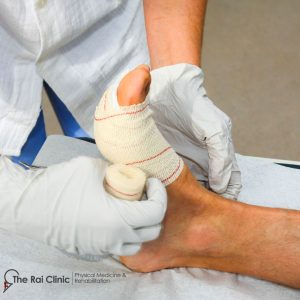Pressure ulcers, commonly known as bedsores, are a significant concern for individuals with limited mobility, such as those recovering from surgery, suffering from chronic illnesses, or confined to a wheelchair or bed. These painful skin injuries develop due to prolonged pressure on the skin, often affecting areas like the heels, hips, tailbone, and elbows. At Physical Medicine and Rehabilitation of Long Island, we offer wound care and specialize in preventing and treating pressure ulcers to improve patient comfort and overall health.
What Causes Pressure Ulcers?
Pressure ulcers develop when prolonged pressure restricts blood flow to the skin and underlying tissues. Without adequate circulation, the 
- Immobility: Patients who are bedridden or use wheelchairs for extended periods are at higher risk.
- Friction and Shear: Repeated movements that rub the skin against bedding or clothing can cause sores.
- Poor Circulation: Conditions such as diabetes and vascular disease can reduce blood flow, increasing the likelihood of pressure ulcers.
- Moisture: Excessive sweating or incontinence can weaken the skin, making it more susceptible to damage.
- Malnutrition: A lack of essential nutrients, such as protein and vitamins, can slow skin healing and increase the risk of ulcers.
How to Prevent Pressure Ulcers
Prevention is the best approach to managing pressure ulcers. Here are some key strategies:
- Frequent Position Changes: Patients should shift their position every two hours if bedridden or every 15-30 minutes if using a wheelchair.
- Use Supportive Surfaces: Specialized mattresses, cushions, and pads help redistribute pressure and reduce the risk of sores.
- Maintain Proper Hygiene: Keeping the skin clean and dry prevents irritation and infections.
- Stay Hydrated and Eat a Balanced Diet: Proper nutrition supports skin health and promotes healing.
- Inspect the Skin Regularly: Caregivers should check for early signs of pressure ulcers, such as redness, swelling, or changes in skin texture.
Treatment Options for Pressure Ulcers
If a pressure ulcer develops, early intervention is crucial to prevent complications. Treatment depends on the severity of the wound:
- Stage 1 (Red, Unbroken Skin): Repositioning, cushioning, and keeping the area dry can help prevent further damage.
- Stage 2 (Open Sore or Blister): Cleaning the wound and applying protective dressings can aid healing.
- Stage 3 (Deep Wound with Tissue Damage): Advanced wound care, including debridement (removal of dead tissue) and specialized dressings, may be required.
- Stage 4 (Severe Tissue Damage or Infection): Surgery, negative pressure wound therapy, or other medical interventions may be necessary.
Contact Physical Medicine and Rehabilitation of Long Island For Wound Care
At Physical Medicine and Rehabilitation of Long Island, we offer comprehensive wound care and rehabilitation services to prevent and treat pressure ulcers. Our team provides treatment plans to improve mobility, enhance circulation, and support overall well-being. If you or a loved one is at risk for pressure ulcers, contact us today to schedule a consultation and receive care.
